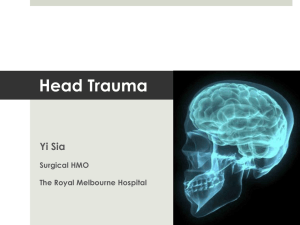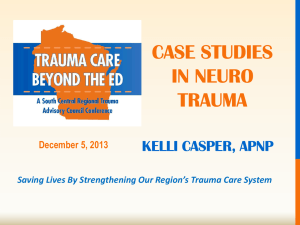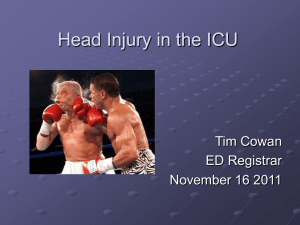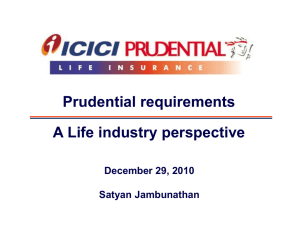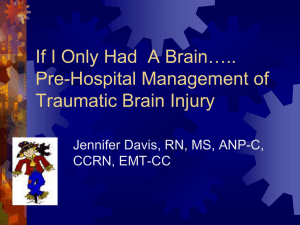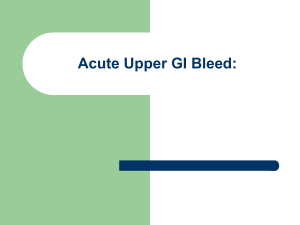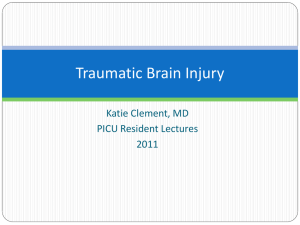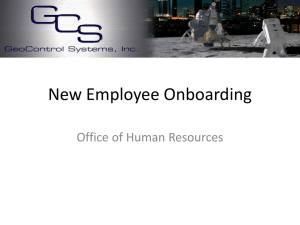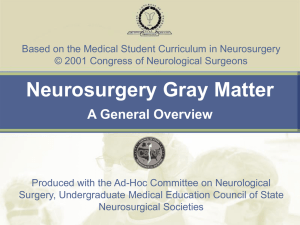Brain Injury 8_08_12 MB
advertisement
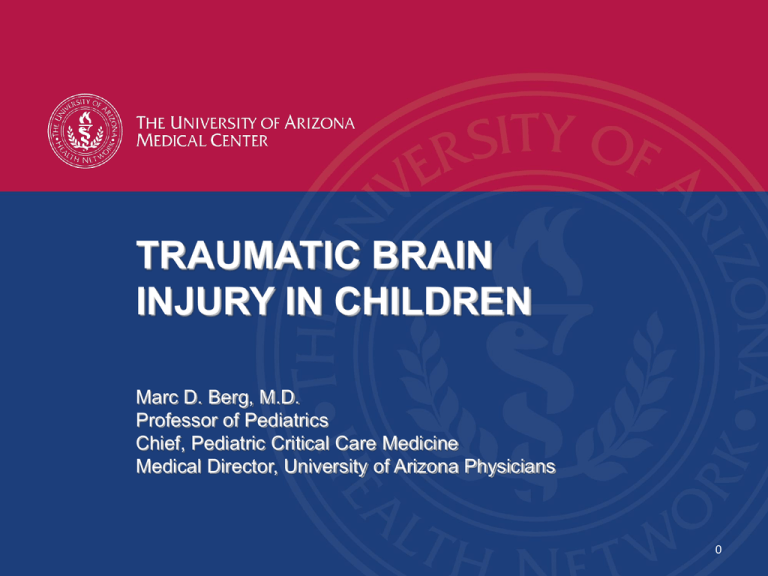
TRAUMATIC BRAIN INJURY IN CHILDREN Marc D. Berg, M.D. Professor of Pediatrics Chief, Pediatric Critical Care Medicine Medical Director, University of Arizona Physicians 0 OBJECTIVES Review Of… Physiology, Assessment, and Management of TBI Outcome in Children With TBI Correct Common Myths CHILDHOOD HEAD INJURIES: STATISTICS • 85% are “mild”, but… • 80% of children with multiple trauma die because of severe head injury (50% in adults) – – – > Head/body ratio Softer skull Open fontanelles MYTH #1 • Myth…All Brain Injuries Are the Same • Fact… Each Brain Injury Is Different DEFINING SEVERITY • Mild Brain Injury – – – – GCS = 13-15 Limited impaired consciousness (<30 min) Normal CT scan Shows signs of a concussion • • • • Vomiting Lethargy Dizziness Lacks recall about injury (<1 hr PTA) DEFINING SEVERITY • Moderate Brain Injury – – – – GCS = 9 - 12 Impaired Consciousness (<24) CT scan Evidence PTA 1-24 hr • Severe Brain Injury – GCS = 3 - 8 – Impaired Consciousness (> 24 hours) – PTA > 24hr CAUTION!! • GCS of 13 may not be so “mild” • SC Stein, J Trauma. 2001;50:759-760 – Reviewed 14 studies (1047 adult patients with GCS of 13) – 33.8% had intracranial lesions – 10.8% required surgery MYTH #2 • Myth… Younger children recover better than older children. • Fact… The developing brain may be at more risk. It will take longer to see the effects of the brain injury. INTRACRANIAL FLUID COMPARTMENTS (INTRACELLULAR AND EXTRACELLULAR) MODIFIED MONROE-KELLIE DOCTRINE For pressure to remain constant, an increase in volume in one compartment must be accompanied by an equal decrease in the volume in others C ICP B A VOLUME CEREBRAL BLOOD FLOW/ AUTO REGULATION • May be lost after trauma • Principles are used in treatment strategies but are the source of much debate From Shapiro HM: Anesthesiology 43:445-471, 1975 CEREBRAL PERFUSION PRESSURE • CPP = MAP - ICP • Useful Concept, But Has Limitations • Good CPP, Better Outcome In Adult Literature (>70 mmHg in adults, >40-65 mmHg ? in children) • The CPP (>70) versus the ICP(<20) As The Primary Therapeutic End-point (Debatable Concept) BRAIN INJURY PATHOPHYSIOLOGY • Primary Brain Injury (occurs at time of impact) – – – – Intracranial hemorrhage Diffuse axonal injury Hyperemia/edema Ischemia, release of toxic mediators SUBDURAL VS. EPIDURAL LifeArt: Williams & Wilkins http://www.lifeart.com SUBDURAL HEMATOMA WebPath: University of Utah http://www-medlib.med.utah.edu EPIDURAL HEMATOMA SUBDURAL VS EPIDURAL HEMATOMA • EPIDURAL – Requires linear force – Associated with skull fracture and torn artery. Brain often uninjured – “Lucid” interval common – Common in accidental trauma • SUBDURAL – Requires significant rotational forces – Associated with brain injury and torn bridging veins – Neurologic symptoms from the start – Common in infants with abusive head trauma PEDIATRIC FALLS FROM HEIGHTS • Falls From 1 - 3 Stories Often Not Fatal • Falls Less Than 4 Feet Often Reported in Fatal Injuries – Unwitnessed – Subdurals – Retinal Hemorrhages • Falling off a Bed or Couch Should Not Kill! COUP - CONTRA COUP INJURY BRAIN INJURY PATHOPHYSIOLOGY • Secondary Brain Injury : – Occurs over hours to days (hypoxia, hypercarbia, hypotension/ischemia, intracranial hypertension, acidosis, seizures, hyperthermia, hypothermia, infections – Potentially Avoidable Or Treatable With Close Monitoring / Treatment of ABC’s UNCONTROLLED INTRACRANIAL PRESSURE AND/OR CEREBRAL PERFUSION DISPLACEMENT OF NERVOUS TISSUES DECREASED GLOBAL AND REGIONAL OXYGEN DELIVERY HERNIATION DEATH WORSE FUNCTIONAL OUTCOME KEY POINTS • THE BRAIN NEEDS OXYGEN • OXYGEN IS CARRIED IN BLOOD NO BLOOD, NO OXYGEN, … …BRAIN CELLS DIE ASSESSMENT MINOR CLOSED HEAD INJURY • Evaluation and Management of Children Younger Than Two years old With Apparently Minor Head Trauma: Proposed Guidelines – Schutzman SA et al., Pediatrics 2001; 107:983-993 • The Management of Minor Closed Head Injury in Children – AAP/AAFP, Pediatrics 1999; 104:1407-1415 IMPORTANT ISSUES FOR THE < 2 YEAR OLDS • • • • • Clinical Assessment Difficult! Occult ICI More Common Increased Risk of NAT Increased Risk of Skull Fracture Increase Sedation Risk MYTH #3 • Myth… A mild brain injury has no consequences. • Fact… A mild brain injury can affect a child’s ability to concentrate, learn and function at home and in school. CASE PRESENTATION • • • • • • • • 6 year old male Struck by car while riding his bike Brought in by EMS with c-spine protected Spontaneously breathing GCS = 8 HR = 145, RR = 25, B/P = 80/45, O2 sats = 99% Multiple abrasions, no other obvious injuries Next Steps? INITIAL ASSESSMENT • A IRWAY • B REATHING • C T SCAN CIRCULATION MANAGEMENT OF TBI INITIAL MANAGEMENT • Level II and III (adult and pediatric): – – – – AVOID HYPOTENSION AND HYPOXIA Know Age Based Normals (For children keep BP > 5th %tile) In adults, MBP > 90. Intubate if GCS < 9 (peds) and Airway or Oxygenation is Unstable (adults) EARLY RESUSCITATION OF CHILDREN WITH MODERATE-TO-SEVERE TRAUMATIC BRAIN INJURY PEDIATRICS 2009;124;56-64 MICHELLE ZEBRACK, CHRISTOPHER DANDOY, KRISTINE HANSEN, ERIC SCAIFE, N. CLAY MANN AND SUSAN L. BRATTON • CONCLUSIONS: Hypotension and hypoxia are common events in pediatric traumatic brain injury. Approximately one third of children are not properly monitored in the early phases of their management. Attempts to treat hypotension and hypoxia significantly improved outcomes. EMERGENCY MANAGEMENT AIRWAY • • • • • • Handle Neck With Caution: Assume C-spine Injury Use Jaw Thrust Avoid Obstruction of Venous Drainage Intubate If GCS < 8 May Need to Protect Airway Due to Seizures or Trauma Intubation Should Be Oral atlas odontoid EMERGENCY MANAGEMENT BREATHING • Even a Small Rise in PaCO2 Causes a Significant Rise in ICP • “Adequate” Breathing May Not Be Enough- Aim for PaCO2 of 35-40 Torr • Hyperventilation Is the Quickest Way to Lower ICP If There Are Signs of Herniation EMERGENCY MANAGEMENT CIRCULATION • Blood Pressure Must Be Optimized to Help Maintain Adequate CPP • Only Use Isotonic Fluids for Volume Expansion • May Need Inotropic or Pressor Support • Control Bleeding EMERGENCY MANAGEMENT DISABILITY • Glasgow Coma Score – Modified for Children • Cranial Nerve Exam – Including Pupillary Response to Light, Eye Position and Movement, Corneal Sensation, Gag • Motor, Sensory, Reflex Exam • Cranial Exam – Evaluate for Fractures, CSF Leak, Battle’s Sign Etc. GLASGOW COMA SCALE • BEST MOTOR RESPONSE (1-6) • EYE OPENING (1-4) 1-none 1-none 2-abnormal extension 2-response to pain 3-abnormal flexion 3-response to voice 4-withdrawal from pain 4-spontaneous 5-localization of pain 6-obeys commands • BEST VERBAL RESPONSE (1-5) 1-none 2-incomprehensible 3-inappropriate 4-confused 5-oriented GLASGOW COMA SCALE (MODIFIED FOR YOUNG CHILDREN) • BEST VERBAL RESPONSE (1-5) • 1-none • 2-restless, agitated • 3-persistently irritable • 4-consolable crying • 5-appropriate words, smiles, fixes/follows MANAGEMENT OF TBI • Guidelines For The Management of Severe (Adult) Head Injury – A joint venture of • The Brain Trauma Foundation • The American Association of Neurological Surgeons • The Joint Section on Neurotrauma and Critical Care – Journal of Neurotrauma, 1996; 13:626-734 – Journal of Neurotrauma, 2000; 17:451-553 – Journal of Neurotrauma, 2007; 24:s1-s106 GUIDELINES FOR THE ACUTE MEDICAL MANAGEMENT OF SEVERE TRAUMATIC BRAIN INJURY IN INFANTS, CHILDREN AND ADOLESCENTS • Crit Care Med 2003 Vol. 31, No. 6 (Suppl.) • Endorsed or supported by: – American Association for the surgery of Trauma – Child Neurology Society – International Society for Pediatric Neurosurgery – International Trauma and Critical Care Society – Society of Critical Care Medicine – World Federation of Pediatric Intensive and Critical Care Society – National Center for Medical Rehabilitation Research – National Institute of Child Health and Human Development – Syntheses USA – The International Brain Injury Association DEVELOPMENT OF GUIDELINES • CLASSIFICATION OF EVIDENCE – CLASS I (PRCT) – CLASS II (“clearly reliable data”) – CLASS III (retrospective, case reviews, clinical series) – TECHNOLOGY ASSESSMENT • DEGREES OF CERTAINTY – STANDARDS (high degree) – GUIDELINES (moderate degree) – OPTIONS (unclear) CASE CONTINUES… • • • • • Pt intubated, on vent 20/Kg Saline given B/P 115/75, HR 120, O2 sat 100% GCS = 7 (Paralyses from RSI resolved) Head CT = small scattered contusions, small non-surgical sub-dural. • Abd CT = neg • C-spine CT = neg What next? MANAGEMENT OF TBI INDICATIONS FOR ICP MONITOR • OPTION (Pediatric): – Severe head injury (GCS ≤ 8) CASE CONTINUES… • • • • Pt has ventriculostomy placed Clear CSF flows freely ICP = 26mmHg MAP = 70, HR = 100, RR = 15 (on vent), O2sat=99%, GCS = 7, PEERL • Questions? Plans? MANAGEMENT OF TBI HYPERVENTILATION (PEDIATRIC) • OPTIONS (no standards or guidelines): – Mild or prophylactic hyperventilation (pCO2 < 35 mmHg) should be avoided. – Mild hyperventilation (30 - 35 mmHg) may be considered for longer periods if ICP refractory to all other tx. – Aggressive hyperventilation (< 30mm Hg) considered second tier for refractory hypertension. CASE CONTINUES… • • • • • • • ABG shows pCO2 of 45 Vent rate increased to 18/min, 20/kg NS IV bolus Repeat pCO2 = 35 ICP still 25, MAP = 75, CPP = 50 Head of the bed elevated to 30o Pt is sedated and paralyzed No change in ICP or CPP What next? MANAGEMENT OF TBI OSMOTHERAPY - PEDIATRIC • STANDARDS: none • GUIDELINES: none • OPTIONS: HT Saline is effective for control of raised ICP (.1-1 ml/kg/hr). Mannitol is effective therapy (0.25-1/kg) for control of raised ICP – Keep osmolarity <320 (maybe higher for HT saline) – EUVOLEMIA MUST BE MAINTAINED! CASE CONTINUES… • Pt started on Hypertonic saline • Repeat CT shows diffuse swelling and evolution of contusions. • ICP now 34, MAP = 70, CPP = 46, PER slugish • HR = 82 • GCS = 5 when not paralyzed What now? Time to quit? Is there a chance for good outcome? OUTCOME IN PEDIATRIC HEAD INJURY LIMITATIONS OF THE GLASGOW COMA SCALE IN PREDICTING OUTCOME IN CHILDREN WITH TRAUMATIC BRAIN INJURY LIEH-LAI MW, THEODOROU AA, ET AL. J PEDIATR 1992;120:195-9 • 64% with GCS≤5 survived • Nonsurvivors had greater incidence of shock/CPR • 45 survivors with GCS3-11 had neuropsychologic testing – – – – 37% memory deficits 30% speech/language deficits 34% motor function deficits 18%attention deficits with or without hyperactivity CASE CONTINUES… • ICP now 34, MAP = 70, CPP = 46, PER sluggish • HR = 82 • GCS = 5 when not paralyzed • Dopamine started, pCO2 now 30, HR = 72, pupils becoming asymmetric… MANAGEMENT OF TBI BARBITURATES • “Option”(Level II for adults): may be considered if ICP control is refractory to other treatment and patient is hemodynamically stable – Reduction in cerebral O2 requirement, ICP – Pentobarbital 2-4 mg/kg/dose, 1-2mg/kg/hour, burst-suppression on EEG – Questionable effect on outcome – Disadvantages: myocardial function - use inotropes. Difficult neuro exam MANAGEMENT CRANIAL DECOMPRESSION • • • • • Ventriculostomy (“option”) Tumor Debulking Hematoma Evacuation Lobectomy Decompressive Craniectomy (“2nd tier”) MANAGEMENT OF TBI STEROIDS • STANDARDS: NOT recommended for improving outcome or reducing ICP in TBI • Useful for edema around brain tumors – Dexamethasone 0.4mg/kg/q 6 hours MANAGEMENT OF TBI SUPPORTIVE MANAGEMENT • Temperature control - Maintain low normal temp. ~35˚c (hypothermia under study) • Head position - 15-30 elevated, avoid jugular compression • Pain control- pain is bad on ICP!!! • Seizure control (prophylaxis is “option”) • Antibiotics • Adequate nutrition (VERY IMPORTANT!!) CRITICAL PATHWAY FOR INCREASED ICP TREATMENT CRITICAL PATHWAY FOR INCREASED ICP TREATMENT CRITICAL PATHWAY FOR INCREASED ICP TREATMENT CASE PROGRESSION… • • • • • ICP normalizes after 2 weeks GCS 8-9 Pt has trach and G-tube Transferred to inpatient rehab after 1 mos Returns to PICU to say “Hi” one year later… MYTH #4 • Myth… A Severe Brain Injury Means that the Child Will Be Permanently and Totally Disabled. • Fact… Patterns of Recovery Vary. – ~80% will have some type difficulty. – The long term consequences are different for each child. OUTCOME IN PEDIATRIC HEAD INJURY • Better Then You Think, (For Severe Injury) So Be Aggressive! • Do NOT Rely on Initial GCS For Prognosis • Mild Brain Injury May Have More Consequences Than Expected • Injury Severity and Level of Family Support May Best Predict Outcome! MYTH # 5 • Myth… The brain injury can’t be that serious if the child came right home from the hospital. • Fact… More children with disabilities go home upon discharge from the hospital than to in-patient rehab. THANK YOU marcb@peds.arizona.edu 62


